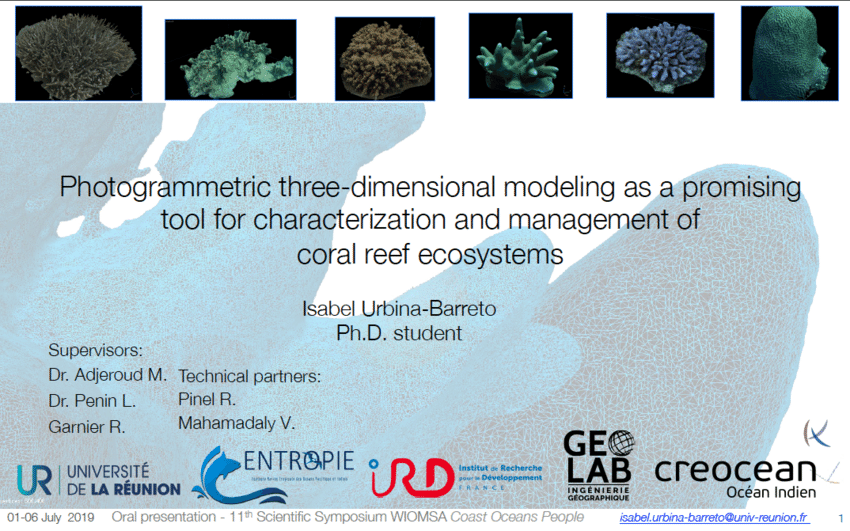
Photogrammetric three-dimensional modeling as a promising tool for characterization and management of coral reef ecosystems
Participation - oral presentation - in 11 WIOMSA symposium (1-6 July 2019). https://symposium.wiomsa.org
Authors: Urbina-Barreto, I.* ; Pinel, R.; Mahamadaly, V.; Elise, S.; Facon, M.; Bureau, S.; Garnier, R.; Penin, L.; Adjeroud, M.
*presenting author
Abstract:
The critical situation of coral reef ecosystems claims towards a rapid improvement of techniques to better characterize their structure and dynamics, in order to implement efficient conservation measures. This implies a better understanding of the relationships between ecosystem function and associated biodiversity. Structural complexity of habitat has become a main focus in coral reef studies, as habitat structure plays a key role in the dynamics of reef communities. Indeed, biodiversity and biomass are strongly linked to this important feature. Since the early 60’s, reef ecology has used two-dimensional tools to assess the structure and function of coral reef communities and habitats. Thanks to new technologies and advances in computer performances in the last decade, a new generation of tools emerged, like Structure-from-Motion (SfM-photogrammetric technique), allowing innovating three-dimensional (3D) assessments. This technique allows a fine quantification of structural complexity and the accurate temporal monitoring of its potential changes. In this talk, we present the results of the first study using underwater SfM applications on coral reefs of the South West Indian Ocean (SWIO) to examine the relationships between fish assemblages and habitat structure among contrasting sites in terms of human impacts and substrate types.The major question addressed is: Can differences in habitat structural complexity explain the variability of associated fish biodiversity? The present study also contributes to establish a baseline for monitoring ecosystem state and function. Simultaneously, 3D models are used as a powerfully and effective communication tool, in order to increase popularity of underwater SfM applications in coral reefs’ studies, management and/or awareness programs.
The study was carried from February to December 2018 on two French islands in the SWIO, which represent two contrasted environments in terms of human impact: (i) Europa Island (French Scattered Islands in the Mozambique channel) is a nearly pristine coral reef ecosystem, (ii) Reunion Island represents a highly impacted coral reefs and offers other substrate types like basaltic spur at underwater lava flows, and coastal installations (e.g. breakwater structures). Eighteen sites were sampled on outer coral reef slopes (5 sites in western Reunion Island / 9 sites at Europa Island), on basaltic spurs (2 sites in eastern Reunion Island), and on coastal installations (2 sites – port and highway breakwater in northern Reunion Island).
Underwater photogrammetry protocols were deployed for data acquisition and were adapted at each site (250-500m2), all models were geo-referenced. Fish surveys were conducted using underwater visual census methods (UVC) at Reunion Island, and video census methods ( stereo camera) at Europa Island. All detected individuals were counted and their size evaluated. Benthic surveys were conducted using LIT (line intercept transect) protocol in Reunion Island.
We used Pix4Dmapper to build 3D models and generate Digital Elevation Models (DEM) and orthomosaics - orthophotos. Global Mapper and QGIS were used to analyse and quantify: physical attributes, surface complexity (3D/2D surface), slope and profiles on DEM and benthic descriptors, mineral substrates and life coral %-m2(classified by growth forms: massive, columnar, branching, foliaceous, helmet shaped, encrusting, tabular, and free-living forms) on the orthophotos.
Diversity, abundance, and biomass of fish assemblages were estimated for each site. Life history traits (diet, size class, schooling, home range, position in the water column, activity) were compiled for each encountered species. Traits were combined to define functional entities.
We looked for correlations between physical attributes and benthic descriptors and functional characteristics of associated reef fish assemblages.
The first results of this study highlighted strong correlations between specific features of fish assemblages and surface complexity at Europa Island. Some types of coral growth forms or other mineral substrates were linked with life history traits and functional entities of fishes.
At Reunion Island, preliminary results showed remarkable differences of fish assemblage response to variations among substrates.
- Habitat structural complexity seem to strongly influence reef fish assemblages.
- Underwater photogrammetry is an economic affordable technique that opens new exciting and pertinent approach to coral reefs studies and management.
- 3D model, DEM and orthophotos are powerful tools to better describe and improve knowledge of coastal and coral reefs ecosystems.
-------------------------------------------------------------------
more information :
- PHOTOGRAMMÉTRIE SOUS-MARINE à la Réunion :
- Underwater photogrammetry :